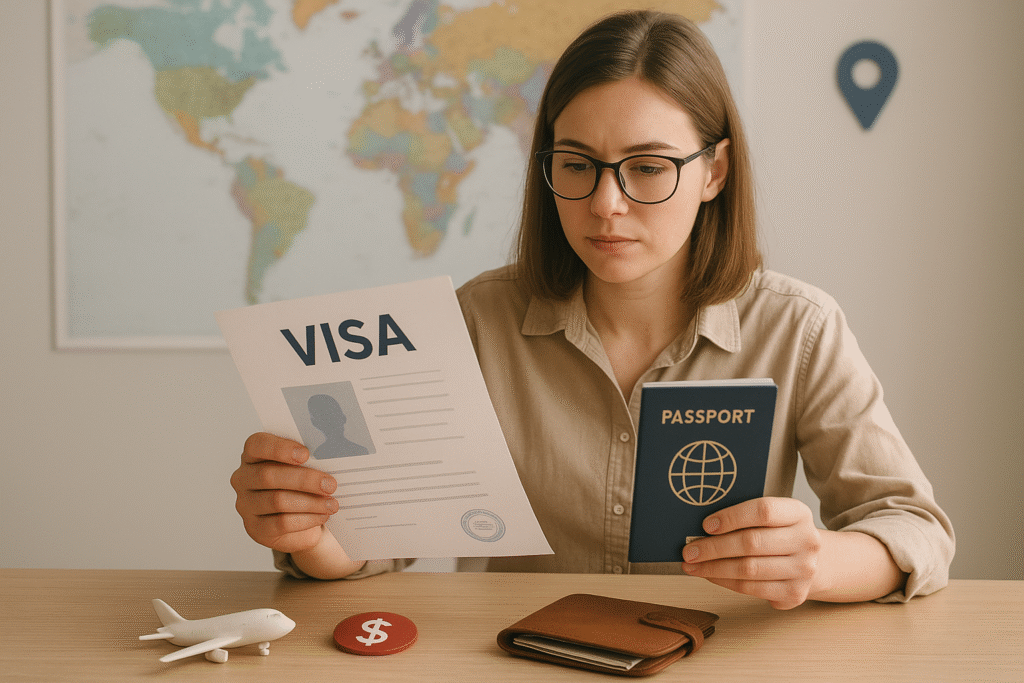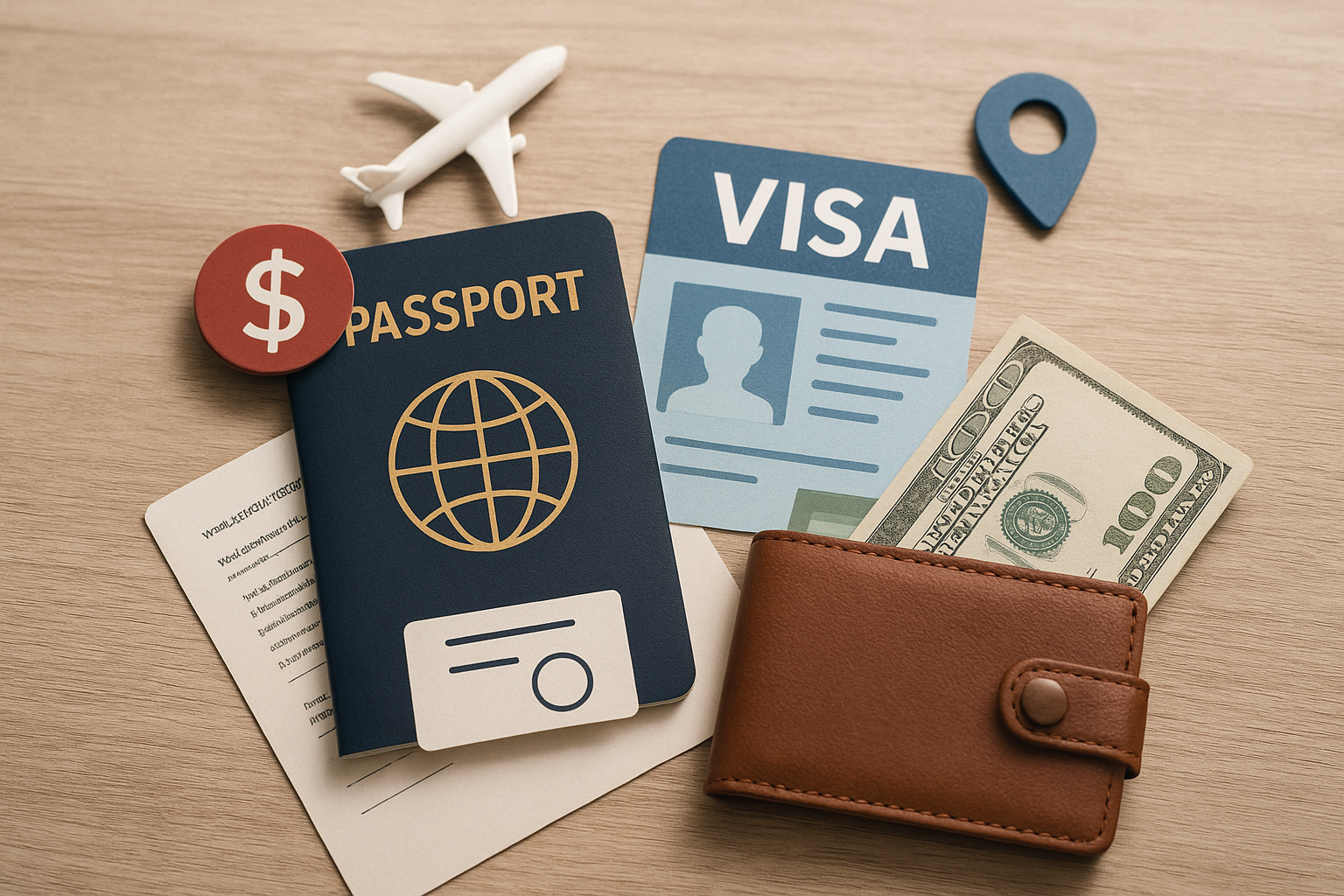The A-Z of Visa Application Fees: A Global Cost Comparison
You’ve found the perfect flight deal, your accommodation is sorted, and your itinerary is coming together beautifully. Then reality hits: you need a visa. Suddenly, you’re staring at government websites trying to decode whether you’ll pay $25 or $250 just for the privilege of entering a country.
Visa application fees are one of those travel expenses that catch people off guard. They vary wildly from country to country, sometimes for reasons that seem completely arbitrary. A short-stay visa to Europe costs roughly the same as a three-month visa to India, while some countries let you in free but charge a “reciprocity fee” at the border. It’s confusing, frustrating, and absolutely worth understanding before you start planning.
This guide breaks down visa costs across the globe, explaining why they differ so much and how you can navigate them smartly. Whether you’re planning a two-week vacation, a year of remote work in Southeast Asia, or a round-the-world trip, knowing what to expect financially makes everything easier.
Why Do Visa Fees Vary So Dramatically?
The cost of a visa isn’t random. Countries calculate these fees based on specific factors that reflect both practical needs and political relationships.
Reciprocity agreements play a huge role. When the United States charges Brazilian citizens $185 for a tourist visa, Brazil responds with a similar fee for Americans. It’s diplomatic tit-for-tat. The same principle applies to many countries, which is why your passport nationality can dramatically change your travel costs.
Administrative expenses matter too. Processing applications requires staff, technology, security checks, and consular resources. Some countries absorb these costs as part of their tourism strategy, while others pass them directly to applicants. Countries with more rigorous vetting processes naturally charge more.
Then there’s policy and immigration control. Some nations use visa fees as a filtering mechanism, deliberately setting higher prices to manage visitor numbers or attract travelers with greater spending power. Others waive fees entirely to boost tourism and economic activity.
Understanding these dynamics helps you see visa fees not just as bureaucratic annoyances but as reflections of international relations and economic priorities.

The Real Cost of Entry: Region by Region
North America
United States
The U.S. maintains some of the most expensive visa fees globally. A standard B1/B2 tourist visa costs $185, which doesn’t include the interview appointment or any expedited processing. Students face additional hurdles with the SEVIS fee of $350 on top of the visa application cost.
Work visas get even pricier. An H-1B petition fee alone runs $460, and when you factor in legal assistance (often necessary given the complexity), total costs easily exceed $2,000. The message is clear: accessing the U.S. requires significant financial commitment.
More details at the U.S. Department of State.
Canada
Canada offers more affordable options. A visitor visa costs CAD $100 (roughly $73 USD), though you’ll need to add CAD $85 for biometric collection, now mandatory for most applicants. Study and work permits run around CAD $150-155.
The good news? Once approved, Canadian visas typically offer generous validity periods, sometimes up to 10 years for tourists, making the cost per visit quite reasonable.
Europe
Schengen Area
The Schengen visa represents exceptional value. For €80 (about $85 USD), you gain access to 27 European countries for up to 90 days within a 180-day period. Children aged 6-12 pay half price at €40, and kids under 6 enter free.
This single visa covers France, Italy, Spain, Germany, Greece, and most of Western and Central Europe. When you calculate the cost per country, it’s one of the most economical visa options available. Apply through the consulate of your main destination country or the first country you’ll enter.
United Kingdom
Post-Brexit, the UK operates its own visa system with notably high fees. A standard 6-month visitor visa costs £115 ($140 USD), but the pricing structure becomes steep for longer durations:
- 2-year visa: £400 ($480)
- 5-year visa: £771 ($930)
- 10-year visa: £963 ($1,160)
If you’re planning multiple UK trips, the math might favor a longer-term visa. But for a single visit, the UK ranks among the pricier European destinations.
Asia-Pacific
Australia
Australia’s standard visitor visa (subclass 600) starts at AUD $150 (around $95 USD). The Electronic Travel Authority (ETA), available to passport holders from countries like the U.S., Canada, and Japan, costs just AUD $20 but only covers shorter stays.
The Working Holiday visa runs about AUD $635 ($400 USD), popular among young travelers looking to work while exploring Australia.
Japan
Japan keeps visa costs reasonable. A single-entry tourist visa costs approximately ¥3,000 (about $20 USD), with multiple-entry visas up to ¥6,000 ($40). Processing is generally smooth, though Japan still requires applying through consulates or authorized agencies rather than online systems.
India
India’s e-Visa system offers surprising flexibility. Tourist e-Visas range from $25 to $100 depending on duration and season. The one-year multiple-entry tourist visa provides excellent value at $80, particularly for travelers exploring extensively or making return visits.
Peak season (April-June and October-March) sees the highest fees, while other periods offer better rates.
Thailand
Most Western passport holders enjoy visa-free entry to Thailand for 30-60 days, but those needing tourist visas pay around $40 USD. Thailand also recently launched a Long-Term Resident (LTR) visa targeting remote workers and retirees, though at a significantly higher cost.
China
China’s visa costs vary by nationality due to reciprocity. U.S. citizens typically pay around $140 USD for a tourist (L) visa, while citizens of other countries might pay $30-60. Processing times and entry restrictions can be unpredictable, so apply well in advance.
Africa
Kenya
Kenya’s eVisa system makes entry straightforward at $50 USD. The East Africa Tourist Visa, covering Kenya, Uganda, and Rwanda for 90 days, costs $100 and offers excellent value for multi-country safaris.
Tanzania
Standard tourist visa: $50 USD for most nationalities. However, U.S. citizens face a reciprocal fee of $100. Visas can be obtained on arrival at major entry points or online beforehand.
Egypt
Egypt keeps fees accessible to encourage tourism: $25 USD for single-entry and $60 for multiple-entry visas. Visa on arrival is available at Cairo Airport and other major entry points, making last-minute travel feasible.
Morocco
Many nationalities, including U.S., Canadian, UK, and EU passport holders, can enter Morocco visa-free for up to 90 days. This generous policy has helped Morocco become one of Africa’s most visited destinations.
Latin America
Brazil
Brazil’s visa requirements depend heavily on reciprocity. U.S. citizens previously needed visas costing around $160, though Brazil has recently experimented with visa-free policies to boost tourism. Currently, U.S. passport holders can enter visa-free for tourism, but this policy has changed multiple times, so verify before booking.
Argentina
Argentina waives tourist visas for most nationalities but historically charged reciprocity fees for U.S., Canadian, and Australian citizens upon entry. These fees have been suspended and reinstated multiple times depending on economic conditions. Always check current requirements.
Colombia & Peru
Both offer visa-free entry to most Western passport holders for 90-180 days, making them incredibly accessible for travelers and digital nomads. This welcoming approach has contributed to their rising popularity among remote workers.
Mexico
Mexico doesn’t charge for tourist cards (FMM) for visitors arriving by air, though there’s a fee included in airline tickets. Land border entries may require paying approximately $30 USD for the tourist permit. Many nationalities enjoy 180-day stays, making Mexico a digital nomad favorite.

Digital Nomad Visas: A Different Category
Traditional tourist visas weren’t designed for remote workers, but dozens of countries now offer specialized digital nomad visas. These cost more but provide legal work rights and extended stays.
Portugal’s D7 Visa
While primarily for passive income earners and retirees, this temporary residence visa (around €90-180) attracts many remote workers. Portugal’s appeal includes quality of life, relatively low cost of living, and EU access.
Estonia’s Digital Nomad Visa
One of the first countries to offer this visa type, Estonia charges €80-100 for up to one year. As a Schengen member, this visa allows travel throughout the zone, making it particularly attractive.
Barbados Welcome Stamp
At $2,000 USD for individuals ($3,000 for families), Barbados isn’t cheap, but it offers 12 months in a Caribbean paradise with reliable internet and no income tax on foreign earnings. For high-earning remote workers, the lifestyle trade-off justifies the cost.
Costa Rica’s Rentista Program
Modified to accommodate remote workers, Costa Rica’s program costs around $100-300 for processing plus proof of stable income. The country’s biodiversity, outdoor lifestyle, and established expat community make it worth considering despite the paperwork.
Croatia’s Digital Nomad Visa
A relative newcomer at roughly €60-80, Croatia offers 12 months in one of Europe’s most beautiful countries. The Adriatic coast, affordable living costs, and growing nomad community add significant value.
Dubai’s Virtual Working Program
At $287 USD for one year, Dubai attracts remote workers with tax advantages, modern infrastructure, and strategic location between Europe and Asia. However, cost of living significantly exceeds the visa price.
Mexico’s Temporary Resident Visa
While technically not a “digital nomad visa,” Mexico’s temporary residency (around $225-400) allows stays up to four years, making it one of the most cost-effective options for long-term remote work. Renewal costs are minimal.
The Hidden Costs Nobody Warns You About
The visa application fee is just the beginning. Smart travelers budget for these additional expenses:
Service center fees: Many countries require applying through third-party visa centers (VFS Global, TLScontact, etc.) that add $20-50 in handling fees per application.
Biometric collection: Canada, the UK, Australia, and others charge separately for fingerprinting and photos, typically $85-120 per person.
Translation and notarization: Documents not in English or the destination country’s language need certified translation, costing $30-100 per document.
Travel insurance: Some visas require proof of coverage for the entire trip. Depending on duration and age, this adds $50-300+ to your costs.
Courier services: Passport returns often require prepaid shipping, adding $15-40.
Currency conversion fees: Paying in foreign currency through credit cards can add 2-3% in fees unless you use cards without foreign transaction charges.
Expedited processing: Need your visa faster? Rush services can double or triple the base fee.
For a family of four applying for Schengen visas with service center fees, biometrics, and insurance, the total easily reaches $500-600 beyond the actual visa costs.
Smart Strategies to Reduce Visa Expenses
Leverage passport power: If you hold dual citizenship, compare visa requirements for each passport. Sometimes one nationality offers visa-free entry while the other doesn’t.
Use e-Visas whenever available: Electronic applications typically cost less than embassy visits and eliminate courier fees. Countries like India, Turkey, Kenya, and Sri Lanka offer efficient e-Visa systems.
Time your applications strategically: Some countries offer reduced fees during off-peak seasons. India’s e-Visa, for example, varies by travel period.
Consider visa-free alternatives: With 199+ visa-free destinations available to some passport holders, you might not need a visa at all. Check resources like Passport Index to explore your options.
Apply for longer validity: If you’ll visit repeatedly, multi-entry or longer-term visas save money over multiple single-entry applications. Calculate the cost per entry to determine the best value.
Bundle family applications: Some countries offer family rates or reduced fees for children. Group applications can also save on service center fees.
Research fee exemptions: Students, journalists, certain professional categories, and children often qualify for reduced or waived fees. Always check if you’re eligible.
Join loyalty programs: Frequent business travelers might benefit from expedited processing programs like U.S. Global Entry ($100 for 5 years) or Canada’s NEXUS ($50 for 5 years), which include trusted traveler benefits and can streamline future applications.
When Visa Costs Are Worth It
Not all expensive visas are bad value. Consider the full picture:
A $185 U.S. visa valid for 10 years costs less than $20 per year. For someone visiting family annually or conducting regular business, that’s entirely reasonable.
Similarly, the $85 Schengen visa covering 27 countries for 90 days breaks down to about $3 per country, making it one of travel’s better bargains.
Even pricey digital nomad visas can represent excellent value when compared to visa runs, border-hopping complications, or the stress of overstaying. Legal status brings peace of mind worth far more than the upfront cost.
Planning Your Visa Budget
Here’s how to approach visa costs in your travel planning:
1. Research early: Visa requirements and fees change regularly. Check official government websites 3-6 months before travel, not visa agency sites that might be outdated.
2. Create a spreadsheet: For multi-country trips, list each destination’s visa requirements, costs, processing times, and validity periods. This prevents surprises and helps optimize your route.
3. Factor in processing time: Budget permitting, standard processing is almost always cheaper than expedited service. Apply as early as rules allow.
4. Keep emergency funds: Visa denials happen, and reapplication costs money. Budget an extra 20-30% beyond your calculated visa expenses for contingencies.
5. Document everything: Save copies of all applications, receipts, and correspondence. These become crucial if issues arise or you need to reference details for future applications.
The Future of Visa Fees
Trends suggest visa processes are becoming more expensive but also more convenient. Electronic systems reduce processing times and often cost less than traditional applications. More countries are introducing biometric requirements, adding expense but improving security.
Digital nomad visas represent the fastest-growing category, with new countries launching programs almost monthly. While initially expensive, competition may eventually drive prices down as countries vie for remote workers’ business.
Climate considerations are also emerging in visa policies, with some nations discussing carbon offset requirements or environmental fees attached to visitor visas. Stay informed about these evolving requirements.
The Smart Traveler’s Takeaway
Visa fees are an unavoidable part of international travel, but they don’t have to derail your plans or budget. By understanding why costs vary, planning ahead, and making strategic choices, you’ll spend less time worrying about paperwork and more time enjoying your adventures.
The key is treating visa research with the same attention you’d give to booking flights or accommodation. A few hours of preparation can save hundreds of dollars and prevent stressful last-minute problems.
Every country you want to visit has its own quirks, requirements, and costs. Rather than seeing this as frustrating bureaucracy, view it as part of the journey. Each visa stamp represents a new chapter, a border crossed, a culture embraced. The fees might sting initially, but the experiences they unlock are priceless.
Before your next trip, give yourself time to understand the visa landscape, budget accordingly, and apply confidently. Your future traveling self will thank you when you’re boarding that plane with all documents in order and no financial surprises waiting.
Safe travels, and may your visa applications be swift and affordable.
Related Post: Beyond the Passport: The Rise of E-Visas and Online Application Platforms













